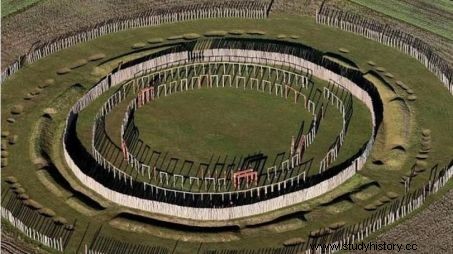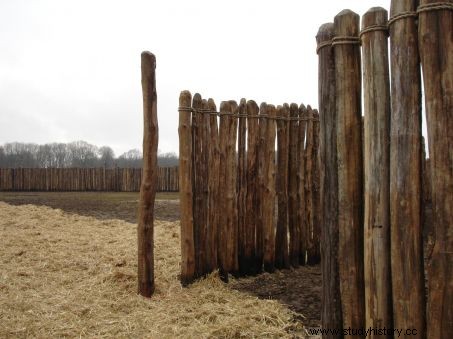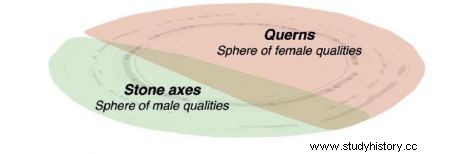Remains of sacrificed women and children have been found in a circular enclosure over 4,000 years old in Germany.
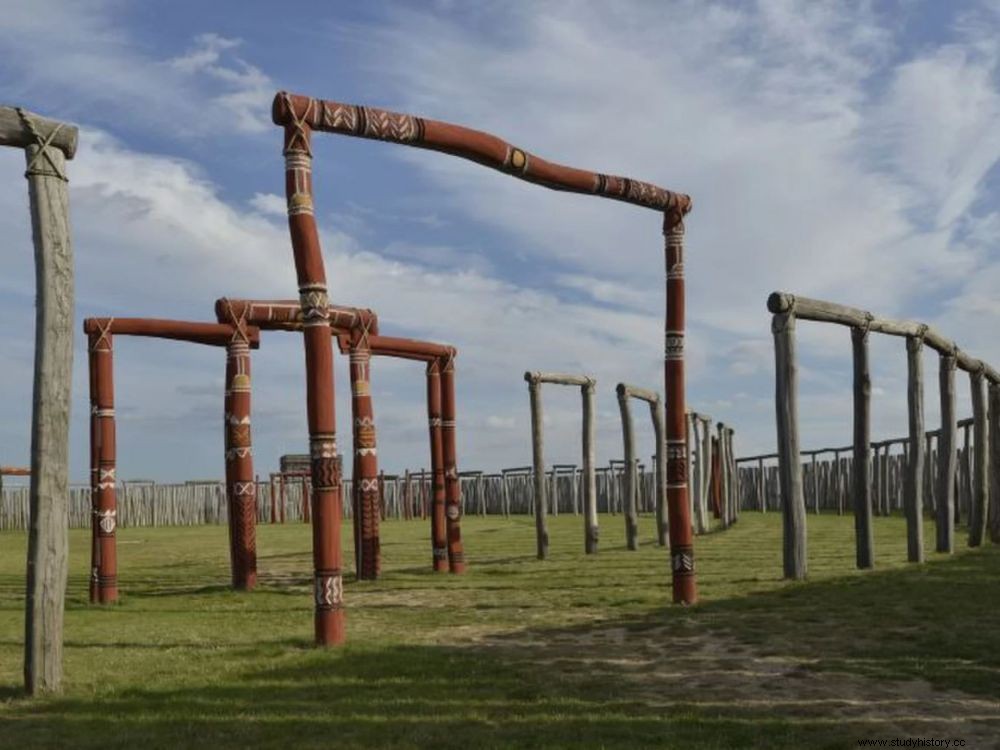
Reconstruction of the wall of Pömmelte (Germany), dating back 4300 years.
4500 years ago, at the dawn of the Bronze Age (2500-600 BC), the great megalithic rings erected in the heart of England were not the only ones to cast their shadows over lands occupied by Neolithic populations. On the mainland, ancient Europeans had also long since erected huge circular enclosures, similar to those at Stonehenge (2800-1100 BC). With the notable difference that wood often replaced stone. In a recent publication of the journal Antiquity, German researchers disclose the results of a study conducted from 2003 to 2008 on one of these gigantic sanctuaries (Kreisgrabenanlagen ), located in Pömmelte, near the city of Magdeburg, Germany.
Reconstruction of the Pömmelte site with its wooden rings. © Landesamt fur Denkmalpflege und Archäologie Sachsen-Anhalt
"The henge of the British Isles are generally considered to represent a quintessentially British phenomenon, unrelated to mainland Europe, but this position should now be reconsidered ", thus wrote André Sptazier and François Bertemes, the two prehistorians, co-signatories of the article. Pömmelte has indeed revealed many secrets. Over the years and meticulous work, it is a wide site of 115 m in diameter , consisting of seven concentric circles formerly materialized by wooden pillars, which the specialists tore from the ground about a hundred kilometers southwest of Berlin.There, on the banks of the Elbe, was a sanctuary with entrances arranged according to astronomical alignments. The oldest part, raised from the third millennium between 2321 and 2211 BC, contained bell-shaped pottery, typical of this period. The enclosure would have been exploited in an uninterrupted way until its dismantling around 2050 BCE. "Pömmelte was then used more sporadically between 1636 and 1488 BCE" , specify the anthropologists.
The central surface - with a diameter of about 47 m - was surrounded by two rings of posts. And in 29 wells dug in these circular ditches had been deposited objects. Repeated burials, carried out during rituals reproduced over several centuries. The archaeologists encountered mixed with the sediments, remains of ceramics, millstones intended to grind cereals, animal bones, stone axes... but also, human remains! Among the dismembered bodies of a dozen women and adolescents, some bore the marks of head trauma in addition to fractured ribs! "They looked like they had been thrown or pushed into the pit “Said the head of these investigations, André Spatzier, archaeologist at the National Office for the Protection of Historic Monuments in Baden-Württemberg (Germany). On the other hand, there existed in another segment of the site, thirteen graves of men buried with care. "Their general orientation facing east and their location in the eastern half of the enclosure seems to reflect an association of death with the sunrise" , the researchers added.
Film Video of the neolithic enclosure of Pommelte YouTube
What could have been the uses of these henges ?
There is a link that is impossible not to make with the famous celestial disc of Nebra, the oldest known representation of the sky from the European Bronze Age (read Sciences et Avenir n°709 ). In this Land of Saxony Anhalt (read box ), on Mount Mittelberg, was found in 1999, an extraordinary object fashioned 3600 years ago, revealing the very advanced knowledge that men of that time already had of celestial complexity. And in Pömmelte, this relationship with the sky is not only expressed through the careful burials that some men seem to have received, it is also underlined by the alignment with the solar star of the four main entrances of this monumental circular enclosure. .
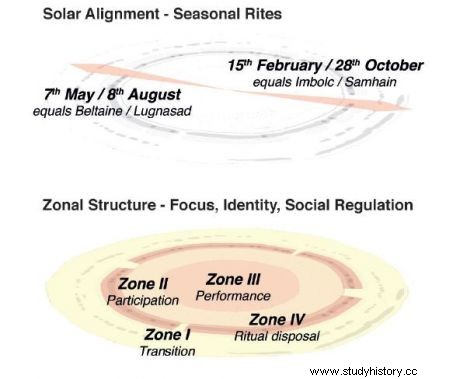
Solar alignments and seasonal rites in Pömmelte. ©André Spatzier
"Pömmelte offers details of ritual behavior and how people organized these spaces. A sacred interior, separated from a profane environment, where rites took place to ensure the continuity of the social order, spiritual and cosmic" , experts say. And like Stonehenge, as the architectural transformations progressed, the two sites developed into sanctuaries with increasingly complex religious functions, including in relation to a cult of the dead. "These circular enclosures have been reported in large numbers in the middle Danube (southern Slovakia and Hungary), in Lower Austria, from Bavaria to Moravia, in Bohemia and Saxony-Anhalt, as well as in central Europe ", the authors recall. In Germany, one of the first even dates back 7000 years!
One of the entrances to the prehistoric circle of Goseck, in the state of Saxony-Anhalt, Germany. ©Bernadette Arnaud
This is the astronomical observatory of Goseck (studied by François Bertemes). "These sites were very important for the first farmers who arrived in Europe around 6500 years ago. They made it possible to determine the cycle of the seasons and the agricultural year. Men needed to know the periods for sowing but also for harvesting ", had at the time explained to Sciences et Avenir the scientist. The circular enclosures of Pömmelte were also arranged in connection with the equinoxes and solstices, major periods for the agrarian communities.
Separation of male-female spheres at the Pömmelte site. ©André Spatzier
"We believe that such enclosures represent complex metaphors, -perhaps cosmological geographies-, related to fertility and reproduction, as evidenced by the differentiated spaces in which ferns, feminine symbols of fertility, life and death, transformation, in the northeast, and stone axes associated with masculinity and power in the southwest half" . To date, more than 250 henges have been identified across Europe.
The Nebra Disc (excerpt from Sciences et Avenir n°709 )
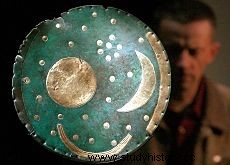
© Halle museum
Largest archaeological discovery made in Europe since that of Otzi , the Iceman, the copper disc unearthed in 1999, in Nebra, near Leipzig in Germany, is a real UFO. On the beautiful green bronze plate 32 cm in diameter, delicate gold ornaments made it possible to distinguish 32 stars, -including the small stellar cluster in the constellation of the Pléiade-, the moon and the sun, and in border, elements representing the horizon and a boat. Two centuries before the Mesopotamians and the Hittites, populations of the Bronze Age considered primitive had been able to represent the celestial vault with a very high degree of precision. This unique disc is exhibited at the museum in Halle, Germany.

